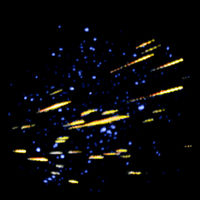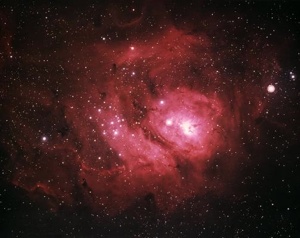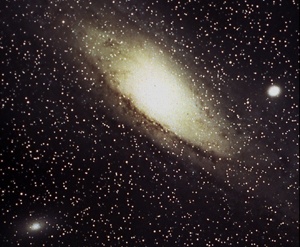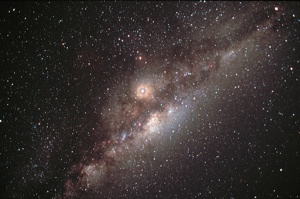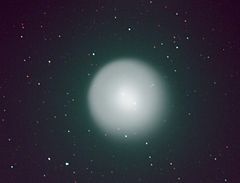Nothing you see will resemble the spectacular Hubble images. But stargazing tends to be more of a spiritual and intellectual excursive than an aesthetic one. Just knowing that I am seeing actual photons released 2.5 million years ago from a galaxy far, far away leaves a deeper impact on me than beautiful space photographs. Scanning the Milky Way on a truly dark, clear, moonless night has a beauty deeper than its aesthetic appeal. It’s also a connection to our ancient roots. No matter how much I learn from science, I believe silently contemplating a dark sky evokes feelings similar to those of mankind since the dawn of time. So the next time you’re in a dark sky — or even your light-polluted city — take out your dusty pair of binoculars, stretch out, and look up to see what heavens await. Note: this is a boreal-centric compilation. My apologies to those in the southern latitudes. 10. Satellites and Meteors
Satellites and meteors can and are seen by the naked eye, but in light polluted skies, many are too dim to see. Meteors: Only the very brightest of the almost constant supply of meteors are observed. While scanning the sky with your binoculars, you are almost guaranteed to see a small streak of light shooting through your field of vision. Only the light gathering power of binoculars coupled with their large field of view (compared to telescopes) reveal these tiny, random acts of celestial violence. (A list of annual meteor showers can be found here.) Satellites: Big and bright satellites are easily visible with eyes alone. Lay down and stare up one hour or two after sunset or before sunrise (the low orbit of satellites makes them invisible due to earth’s shadow in the middle of the night). You’ll notice points of light moving slowly across the sky. They seem like airplanes, but the lights won’t blink. Follow them for as long as you can; their altitude and path determine where in the sky they’ll disappear behind the Earth’s shadow. Like meteors, many satellites too dim for eyes alone are revealed through binoculars simply by looking up. (A fantastic resource for satellites of all types (natural and manmade), is Heavens-Above. Want to know when Hubble, the ISS, or the Space Shuttle will fly over head? Enter your location, and Heavens-Above will tell you exactly when and where to look. It also predicts the very localized occurrence of iridium flares; highly reflective communication satellites that at times are brighter than anything else in the night sky, save the moon. Sometimes bright enough to see in the daylight!)
- The Moon
A source of wonder, romance, and reflection since man stood up and then looked up. The brightest object in the night sky is easily visible with the naked eye, but with a pair of binoculars, much detail is revealed. The best time to view details of the moon is not necessarily during a full moon. As Galileo first noticed, the most detail is seen at the moon’s terminator; the shadow line on the moon separating the visible phase from the rest of the disk. Shadows cast along the terminator illuminate detail of the mountains and valleys of the moon. Impact craters untouched by atmosphere and erosion show the violent history of the early solar system. And the moon’s darker seas (mares) reveal the ancient, active geological life of lava flows long since dormant. Lunariffic! 8. Jupiter
Or more precisely, the Galilean moons of Jupiter. Observing the planets is one job where telescopes really come into their own, but binoculars are all you need to see the four largest of Jupiter’s moons. The moons are actually bright enough to see with the naked eye, but are washed-out from Jupiter’s powerful glare. Your binoculars will show them as little stars grouped around the gas giant. Track their nightly waltz around the giant planet. (For viewing tips and a Java tracking utility go here.) 7. The Double Cluster (NGC 884 & NGC 869)
Located in the constellation Peruses, the Double Cluster is actually two different star clusters very close together. A star cluster is a dense grouping of stars. The Double Cluster makes a fantastic binocular target because it’s a comparatively large object in the night sky. It has an apparent (angular) size of 60 minutes (1 degree). A telescope’s field of view is often too narrow to enjoy both clusters at the same time. Binoculars have fields of view as wide as 6 degrees or more, easily spacious enough to fit the entire Double Cluster. (Angular size in the night sky: horizon to zenith is 90 degrees; horizon to horizon — the entire visible sky dome — is 180 degrees.)
- The Beehive Cluster (M44)
The Beehive, like the Double Cluster, is another open star cluster. Located 577 light years from Earth, the Beehive is found in the constellation Cancer. It was one of the first objects Galileo studied with his telescope, and makes a fantastic binocular target because of its apparent size in the night sky.
- The Lagoon Nebula (M8)
Many nebulae are areas of interstellar gas condensing — via gravity — to form new stars and star systems: stellar nurseries. The Lagoon Nebula is considered one of the prettiest sites in the night sky. Find it in the constellation Sagittarius, but only during the summer in mid-northern latitudes.
- The Orion Nebula (M42)
The Orion Nebula is the smudge on the Hunter’s sword in the Orion constellation. Orion is the most recognizable constellation in the winter sky, and a thing of beauty in its own right. The nebula is a star factory some 1,270 light years away, making it the nearest star nursery to Earth. Its apparent size in the night sky is 1 degree. 3. The Pleiades (M45)
Mentioned three times in the Bible, and a source of inspiration for virtually every ancient culture, the Pleiades may be my favorite binocular target, perhaps because it was my first. In my teens, I got the idea to use some binoculars skyward after I stumbled upon an old, small, cruddy pair stored away in the house. My first target was the Pleiades, and I suppose it was love at first sight. This small (in star quantity) star cluster is also a birthplace for new stars, although the nebulosity is usually only visible in time exposure photography. It is super easy to find with the naked eye, but dramatically different with binoculars. Its apparent size is much to large to fit into most telescope fields of view, and so again makes a choice binocular target.
- Andromeda Galaxy (M31)
The best thing about the Andromeda Galaxy? It’s a galaxy! A trillion suns. Over 2.5 million light years distant. Orbited by fourteen dwarf galaxies, at least one of which (M32), and possibly another (M110) can also be seen in your binoculars at the same time. What’s not to love? Andromeda is the furthest thing you can see with the naked eye (appearing as a faint smudge in the sky). With a total apparent size of about 4 degrees, or more than 8 times the apparent size of the full moon, it makes an outstanding object for binoculars. It’s usually the first thing I locate when I look up at night with a pair of binoculars. Fun fact: Andromeda and our Milky Way are moving toward each other at a good clip. In about 3 billion years our descendants will likely witness the Andromeda-Milky Way collision. I wonder how the night sky will look with another trillion suns in the mix.
- The Milky Way
The delicate, silvery cloud stretching across the sky on dark, clear nights is our home galaxy: the Milky Way. Lazily scanning the Milky Way flat on your back on a summer night is an astronomical treat not to be missed. With binoculars, the silver cloud reveals its nature: the stars upon stars that make up our galaxy. No part of the sky is more densely packed with visible stars than the Milky Way, nor more pleasantly addictive to behold with binoculars. Be careful not to get lost in there! Bonus: Comets (Act Now!)
Binoculars are almost universally acknowledged as the finest instrument for viewing naked eye comets. Comets, and their expansive, ephemeral tails, can have an enormous size in the sky. Bright comets often fill even the large field of wide angle binoculars. A telescope actually hinders comet viewing though its relatively small viewing window. Comets and binoculars were made for one another. Heavens-Above tracks all comets currently magnitude 12 and brighter (Magnitude 12 is extremely dim; way too dim for binoculars.), and will also show you where in the night sky they can be found. Although comets are often periodical (and thus predictable), the vast majority are too dim to see. The truly spectacular comets often arrive as a surprise. Either a newly discovered comet, or a periodic comet that suddenly becomes much brighter. Such a comet is presently visible in the night sky (November 1, 2007). Periodic comet 17P/Holmes became unexpectedly and inexplicably 1,000,000 times brighter about two weeks ago. A truly rare occurrence. The comet’s tail is currently seen head-on instead of the expansive tail archetype, so it looks like an overgrown, fat, fuzz-ball of a star in your binoculars. (It looks like a fairly bright star with eyes alone.) Keep checking it nightly. Even the experts aren’t certain what will happen. Easily visible comets aren’t in the sky often, so take 5 minutes to go outside and have a look! Contributor: crubel
